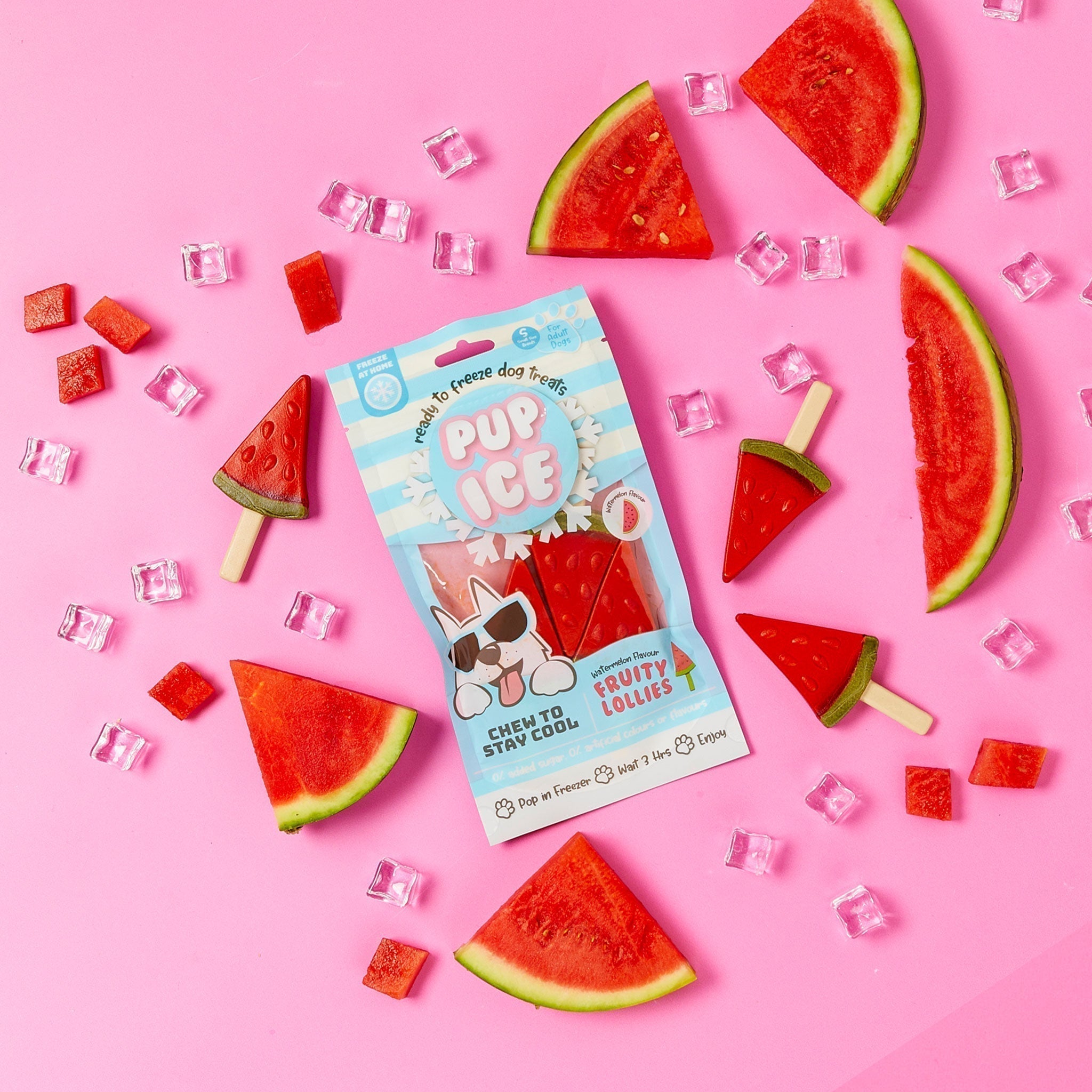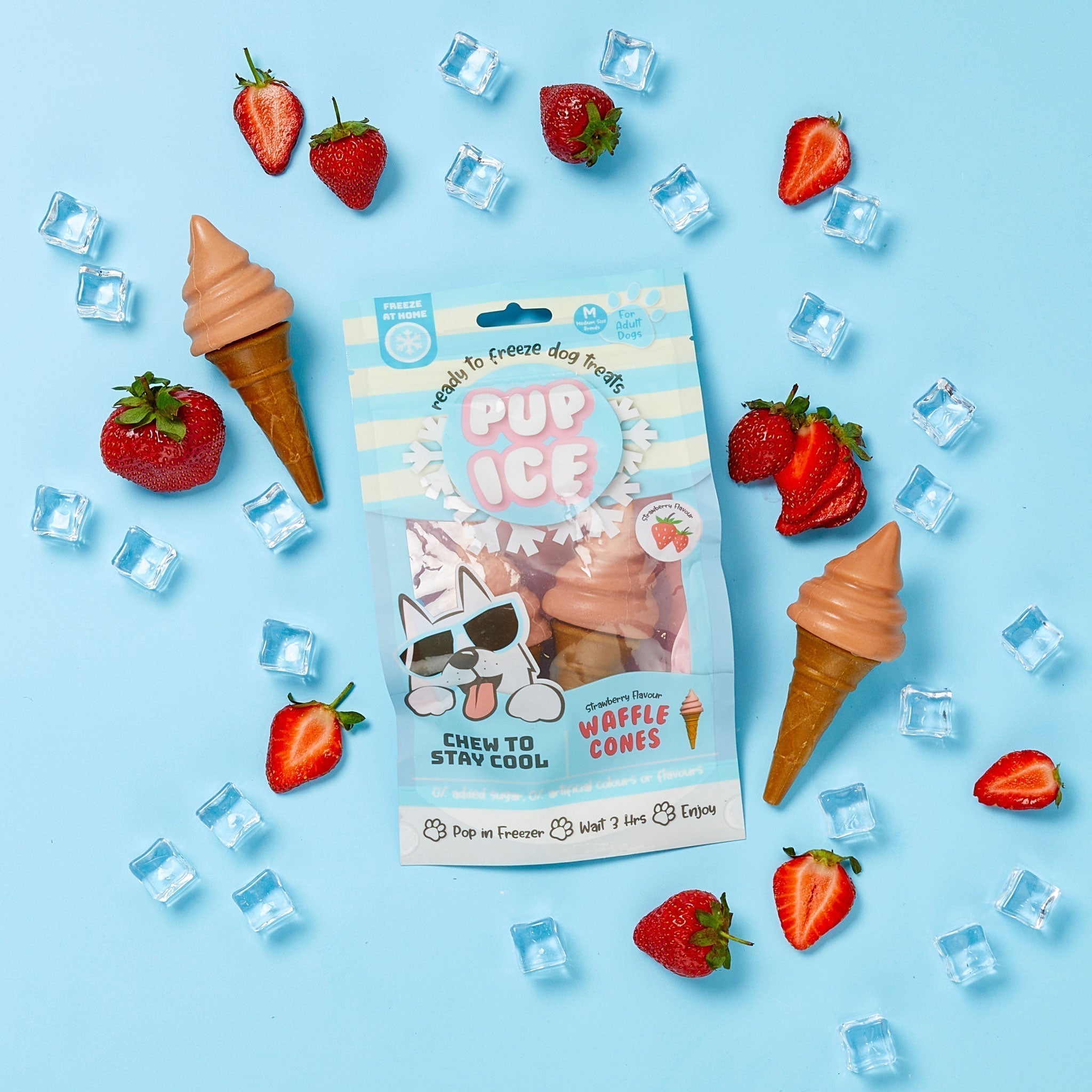Article: How Cooling Dog Treats Can Help with Digestion and Hydration

How Cooling Dog Treats Can Help with Digestion and Hydration
 As pet owners, we’re always looking for ways to enhance our dogs' health and well-being. While most of us know the importance of regular exercise, nutritious food, and mental stimulation, there’s another aspect of dog health that’s often overlooked: hydration and digestion. During the warmer months, ensuring that your dog is properly hydrated and has a healthy digestive system is crucial. One simple, tasty way to support both of these is by incorporating cooling dog treats into your pup's routine. In this post, we’ll explore how cooling treats can contribute to digestive health and proper hydration for dogs.
As pet owners, we’re always looking for ways to enhance our dogs' health and well-being. While most of us know the importance of regular exercise, nutritious food, and mental stimulation, there’s another aspect of dog health that’s often overlooked: hydration and digestion. During the warmer months, ensuring that your dog is properly hydrated and has a healthy digestive system is crucial. One simple, tasty way to support both of these is by incorporating cooling dog treats into your pup's routine. In this post, we’ll explore how cooling treats can contribute to digestive health and proper hydration for dogs.
The Link Between Hydration and Digestion
Before diving into the benefits of cooling treats, it's important to understand the connection between hydration and digestion. Water is essential for many bodily functions, including nutrient absorption, digestion, and the movement of food through the gastrointestinal (GI) tract. Without proper hydration, your dog may experience digestive issues such as constipation, bloating, and discomfort.
In addition to their cooling properties, many cooling dog treats are packed with ingredients that help promote hydration. By encouraging your dog to consume more water in the form of frozen or chilled treats, you are helping to prevent dehydration and, at the same time, supporting their digestive system.
1. Cooling Dog Treats for Hydration
In hot weather, dogs are at an increased risk of dehydration, especially after playing outdoors or during exercise. Just like humans, dogs lose moisture through panting and sweating, and if they aren’t replenishing that lost fluid, they can quickly become dehydrated. Dehydration can lead to lethargy, dry gums, and more severe issues like kidney problems.
Cooling treats as a hydrating solution:
Cooling dog treats, especially those made with hydrating ingredients like coconut water, watermelon, or low-sodium broth, offer a fun and effective way to increase your dog's water intake. These treats often contain a high water content, which is absorbed by the body and helps replenish fluids lost throughout the day.
For example, you can make your own cooling treats at home using ingredients like watermelon (which is 90% water) or coconut water, both of which are naturally hydrating and gentle on the stomach. Freezing these ingredients into a treat form not only makes them appealing to your dog but also ensures that your pup gets a cooling and hydrating snack when they need it the most.
2. Cooling Treats and Digestive Health
Hydration plays a significant role in the health of your dog’s digestive system, but cooling treats can also directly benefit digestion. Certain cooling treats are formulated with ingredients that help soothe the GI tract and promote healthy digestion, making them a great option for dogs with sensitive stomachs.
Digestive-friendly ingredients in cooling treats:
-
Yogurt: Many cooling dog treats contain plain, unsweetened yogurt. Yogurt is a great source of probiotics, which are beneficial bacteria that support gut health. These probiotics help maintain a healthy balance of gut flora, which can promote regular bowel movements and improve nutrient absorption.
-
Pumpkin: Another common ingredient in cooling treats is pumpkin, which is high in fiber and gentle on your dog's digestive system. Fiber helps regulate digestion and can aid in preventing both constipation and diarrhea. It also promotes a healthy gut microbiome, ensuring that your dog’s digestive system stays in balance.
-
Ginger: Ginger is known for its ability to soothe upset stomachs and reduce nausea. Many cooling dog treats include ginger as an ingredient to help with digestion, especially for dogs that experience motion sickness or mild digestive discomfort after eating.
Cooling treats for digestion support:
If your dog has a sensitive stomach or tends to experience digestive issues like bloating or gas, cooling treats with ingredients like ginger, pumpkin, and yogurt can provide relief. Not only will these treats hydrate your dog, but they will also promote digestive health by soothing the stomach and supporting regular digestion.
3. Cooling Treats as Post-Exercise Recovery
After an active day of play or exercise, your dog may experience digestive discomfort due to the physical exertion. Exercise increases circulation, boosts metabolism, and helps the body process nutrients—but it can also make your dog thirsty and possibly leave their digestive system a little “off” for a while.
How cooling treats help after exercise:
Frozen cooling treats can serve as a great post-exercise snack for your dog. Not only do they help cool your dog down and replenish fluids, but the digestive-friendly ingredients they contain can aid in soothing the stomach after physical activity. For example, after a long walk or play session, you can offer your dog a cooling treat made with yogurt or pumpkin. These ingredients will support your dog’s digestion while rehydrating them and providing a tasty reward for their efforts.
4. Frozen Treats: A Dual Purpose Delight
One of the reasons frozen or chilled cooling treats are so beneficial is their dual-purpose nature. While they help to cool your dog down, they also allow for slower consumption, which can promote better digestion. When your dog eats a frozen treat, they tend to chew it more slowly, which gives their digestive system time to process the food and absorb nutrients. This can be especially helpful for dogs that tend to eat too quickly and suffer from digestive upset, like bloating or vomiting.
5. Cooling Treats for Sensitive Dogs
Dogs with sensitive stomachs or food allergies can particularly benefit from cooling treats that are designed with gentle, natural ingredients. When choosing cooling treats for sensitive dogs, look for options that are free from artificial preservatives, colors, and flavorings. Opt for those with simple, whole-food ingredients that are easy on the stomach, such as pureed fruits, vegetables, and natural proteins.
Some cooling dog treats are even specifically formulated to be hypoallergenic, meaning they contain ingredients that are less likely to cause digestive upset or allergic reactions. If your dog has specific food sensitivities, consider consulting with your veterinarian to find the best cooling treat options for their needs.
Conclusion
Incorporating cooling dog treats into your dog’s routine is more than just a fun way to beat the heat—it can also have significant benefits for hydration and digestion. With ingredients like coconut water, yogurt, pumpkin, and ginger, cooling treats help maintain proper fluid balance, promote healthy digestion, and even soothe a sensitive stomach. Whether you’re hydrating your dog after a long walk or providing digestive support after a meal, these cooling treats can be an excellent addition to your dog’s overall health regimen.
So, this summer, don’t forget to treat your dog to something refreshing and nutritious. Not only will they appreciate the cooling relief, but you’ll also be supporting their digestive health and hydration needs—keeping them happy, healthy, and hydrated all season long.


